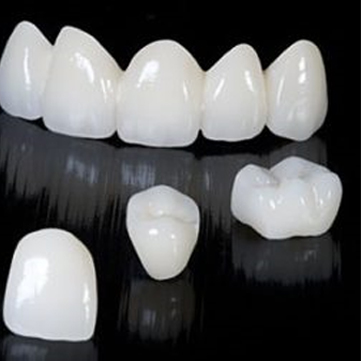Your dental surgeon or prosthodontist may have recommended a crown on a tooth. This maybe to protect a cracked or worn posterior tooth, protect a tooth after a root canal procedure or improve the aesthetics of your smile.
Let’s take a look at your options for crown materials and the pros and cons of each.
Gold crowns – gold has been used in dentistry for many decades. It is an inert metal so causes no allergic reactions however gold itself is very soft so needs to be mixed other metals such as copper and tin to strengthen it. The main advantage of gold crowns are their strength in a relatively thin cross section meaning less tooth tissue needs to be removed to accommodate the crown. There are a few obvious drawbacks to gold crowns. Firstly the cost, they can be expensive depending upon the current price of gold, they are cement retained and occasionally this can fail and the crown can come off and finally the aesthetics. In the posterior of the mouth this is of less of a concern for most patients but rarely is a gold crown requested in the anterior of the mouth.

Porcelain fused to metal crowns (PFM) – like gold crowns these have been successfully used in dentistry for many years. These crowns have a metal substructure with aesthetic porcelain overlayed on top. This improves the aesthetics however these teeth can often look a little dead and lifeless and are prone to chipping during function.
Lithium disilicate (Emax) crowns – these are highly aesthetic crowns that can be fabricated in any shade to match teeth, stained and glazed to add character to the crowns. They exhibit very similar optical properties to natural teeth with excellent translucency and transparency giving them an alive, natural appearance. These teeth are bonded on so have almost no chance to fall off however are quite brittle and need to be a minimum thickness to prevent fracture meaning more tooth structure needs to be removing during the preparation.
Zirconia crowns – like emax crowns these are a type of ceramic which is highly aesthetic and can be custom characterised to mimic natural teeth. Because of the sintering process during fabrication they are extremely hard and often prescribed for patients who clench or grind their teeth. They are also bonded on however the bonding process is very technique sensitive requiring lots of preparatory steps which if not achieved successfully can lead to debonding.
Depending on the area of your mouth you are restoring and your personal preferences and biting habits different material choices may be selected. Talk to your dental surgeon or prosthodontist to work out the best solution for you.
Here at Mosman Dental Surgery we work exclusively with local master ceramicist Max Zuppardi to provide you with a bespoke solution.


Recent Comments